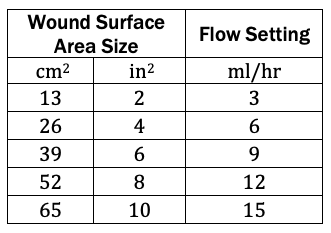Quick Reference Guide

Setting Oxygen Flow Rate & Dressing Application
A key feature of the OxyGeni® System is the ability to supply variable flow rates of oxygen to accommodate various wound sizes. The flow rate is adjustable in the range of 3 ml/hr to 15 ml/hr. Based on the surface area dimensions of the wound, or primary moisture absorbent dressing, the following chart can be used as guidance to set the oxygen flow rate.

Please note and explain to the patient that increasing the oxygen flow rate does not necessarily equate to increasing the oxygen uptake by the wound or increased wound healing. Due to the variable nature of wound sizes, degree of impeding factors to oxygen penetration such as slough and eschar, degree of wound hypoxia, types and sizes of wound dressings, and types and methods of application of dressings, it is difficult to provide precise guidance as to flow rate settings. The chart above should be used as a general guide.
Applying the OxySpur® Dressing
- Prior to application of OxySpur Oxygen Diffusion Dressing, cleanse the wound area as necessary.
NOTE: Do not use petroleum-based or occlusive products in the moist wound bed as they will prevent oxygen from diffusing into the wound tissue. - Select a dressing that will allow the wound contact area to completely cover the wound and extend onto healthy tissue.
- Remove the sterile dressing from the package.
CAUTION: If the immediate product packaging is damaged (torn or punctured) on products marked as sterile, such as the dressings, do not use the damaged products and select an undamaged product.
NOTE: When placing the OxySpur dressing, keep in mind the direction of the cannula (tube) coming from the dressing. It can be helpful to place the dressing so that the cannula is facing up, toward the head of the body rather than pointed to the feet. This will provide the highest range of motion when connected to the OxyGeni.
NOTE: The dressing should always be placed ‘bubble side up” so the foam is in contact with the skin. - For an adhesive dressing (has a hi-tac hydrocolloid border):
NOTE: Use of a skin protectant should be used before placing the adhesive dressing. If you are concerned that the patient’s skin will not tolerate a strong adhesive, we advise using the non-adhesive dressing instead.- Hydrocolloid adhesives work more efficiently when warm. Warm the adhesive portion with your hands prior to application.
- Remove part of the clear liner to expose the adhesive (hydrocolloid) portion of the dressing.
- Position and smooth into place while removing the second half of the clear plastic liner.
- Carefully smooth around the edge of the dressing to ensure good contact between the adhesive film border and the periwound skin.
- Briefly apply pressure to the adhesive until it becomes firmly attached to the skin (hydrocolloids activate with heat and pressure).
- For a non-adhesive dressing (no hydrocolloid border):
- Place the dressing over the wound.
- A secondary film dressing or conforming bandage should be applied over the OxySpur dressing to secure the dressing in place.
- If required, the dressing can be cut, although note that this may increase the risk of product delamination.NOTE: slight pressure should be placed on the entire dressing to ensure that the dressing contacts the surface of the wound. This enables wicking of excess fluid from the wound bed into the dressing and can be achieved using a wrap or a sock.
- For highly exuding wounds, make sure to secure any fixative film over all the edges of the dressing. Ensure that the edges are firmly sealed. Gaps or tears could allow excessive exudate to damage the periwound and potentially lower the oxygen concentration at the wound site, which could affect the efficacy of the therapy.
Dressing Changes
- Dressing change frequency depends on multiple factors, including the condition of the wound as well as on the level of wound exudate. Please consult your clinical caregiver.
- In general, dressings should be changed once strikethrough (wound exudate reaching the top of the dressing) is evident, or the dressing starts leaking.
- DO NOT lift or remove the dressing between dressing changes, unless instructed to do so by your clinical caregiver. Doing so will compromise your wound-healing environment and can affect your healing process.
- To remove a bordered (adhesive) dressing, loosen the adhesive film border before lifting the dressing away from the wound, using a lateral pull.
Note: An adhesive remover and a lateral stretch removal method in combination with a medical adhesive remover may be needed when removing the dressing. - To remove a borderless (non-adhesive) dressing, gently lift the corners of the dressing away from the wound.
- If difficulty is experienced on removing the dressing, it should be irrigated with sterile water or sterile saline solution.

